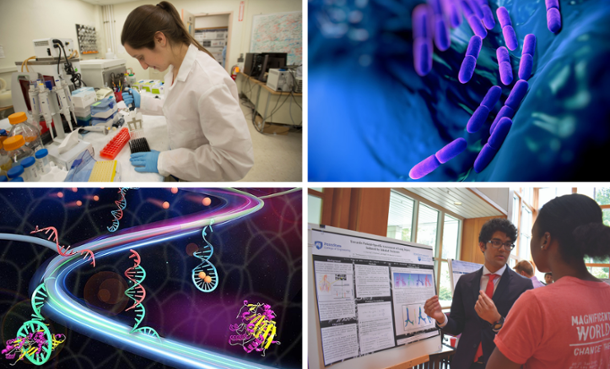
The interdisciplinary research approach and why it works
September 24, 2018
UNIVERSITY PARK, Pa. — If you have access to many brilliant research minds, even if they are outside of your department, then why not use them?
This is the basis of Penn State’s Department of Biomedical Engineering’s interdisciplinary research approach, which leads to a variety of collaborations with departments, institutes, and centers across the University. These partnerships lead to research breakthroughs that may not otherwise be possible.
Meghan Vidt, assistant professor of biomedical engineering, takes an interdisciplinary approach with the Department of Physical Medicine and Rehabilitation in the College of Medicine through her research into the musculoskeletal biomechanics of the shoulder and upper limb. Her applied research involves computational musculoskeletal models developed using mathematical representations of anatomical and physiological phenomena. These models in turn help clinicians develop individual- or group-specific strategies for rehabilitation, including those who recover from breast cancer, strokes, and many other injuries.
“This work would not be possible without an interdisciplinary approach that includes collaborations among physicians, scientists, and engineers,” Vidt said.
Xiaojun Lance Lian, assistant professor of biomedical engineering, collaborates with the Department of Biology and The Huck Institutes of Life Sciences on stem cell engineering research. Lian recently received the Junior Investigator of Advanced Biomanufacturing Award from the Biomedical Engineering Society for his work in differentiating human stem cells into clinically applicable cells, such as cardiac muscle cells and pancreatic beta cells, with small molecules.
Lian notes that traditionally, scientists studied stem cells via a biological approach, examining the structure and function of the stem cell. But the advent of stem cell engineering, which is the interface of engineering with stem cell biology, has resulted in multiple positive outcomes. This includes faster development of new therapeutic products, creation of new jobs, new and effective treatment options for disease and injuries, and lower-cost stem cell-based therapies.
“For example, we have used engineering approaches to successfully develop a completely new human cardiac muscle biomanufacturing method from stem cells,” Lian said.
Another instance of successful interdisciplinary research is James Marden, professor of biology and associate director of The Huck Institutes of the Life Sciences, working with Scott Medina, assistant professor of biomedical engineering, on a potential breakthrough in cancer research.
“I’m presently working with a biomedical engineering lab, The Medina Group, to take an engineered protein we discovered in an unusual environmental sample and use it as an anti-cancer drug,” Marden said. “The combination of field biology and biomedical engineering is allowing this work to happen.”
Why exactly does research lead to such breakthroughs? Marden believes such breakthroughs stem from an interdisciplinary and diverse research approach.
“Different fields have distinct scientific cultures, perspectives, and tools,” Marden said. “Putting them together is enabling for the individual collaborators and results in scientific outcomes they couldn’t have achieved working independently.”
Vidt agrees with Marden regarding the value of the diversity of perspectives, and adds that an interdisciplinary approach often enables research to have a greater impact on society. By bringing together the expertise of different disciplines, she said, researchers can develop outcomes that have a greater potential to benefit others.
“This is due to the more comprehensive solutions that are likely to flow from an interdisciplinary approach,” Vidt said.
The benefits of the interdisciplinary approach are not limited to just research, but also to education. Marden said that exposing students to interdisciplinary education enables them to be inventive and creative.
“Students benefit by being taught to be resourceful, to take a technique or concept from one field and meld it with those from another,” Marden said.
An interdisciplinary education can have a positive and lasting impact on a students’ life, Lian said, and inspire them to use their education not only for personal success, but for the greater good.
“Students will appreciate more of their course materials if they know what they are studying will have a huge influence on society and their course materials directly relate to their future jobs,” Lian said.
By taking an interdisciplinary approach, frequently there are examples in another field that parallel the phenomenon or concept you are trying to teach or explore through research, Lian added. Including these concepts and approaches, both in the classroom and the laboratory, can lead to new areas of learning and discovery.
As for the future of interdisciplinary research and education at Penn State, Cheng Dong, department head of biomedical engineering, said he plans on further advancing the department to become a pivot of the University-wide interdisciplinary cluster in both research and education at Penn State.
“We will continue looking for more opportunities for new cross-disciplinary hires and encouraging all faculty to work with others outside our own department,” Dong said. “We have built so many relationships with our colleagues in many disciplines that have resulted in a lot of fantastic research work already, I think the positive effects of our interdisciplinary research are just beginning at Penn State.”



